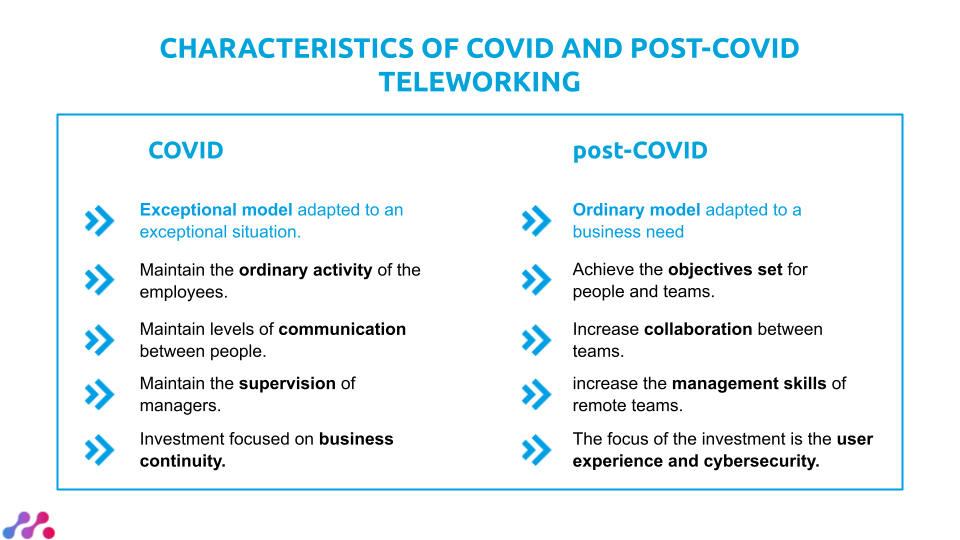The great HR dilemma.
What work model are we going to implement in my company after the pandemic? Many HR managers are now asking themselves that question. The dilemma between returning to the pre-COVID model, keeping teleworking as the preferred option or implementing a hybrid model is a constant in our companies.
In the accompanying graph, I make a brief differentiation between the characteristics of a COVID teleworking model and those that a post-COVID model should have.

To help you reflect, here are some clues about what a good management model should contain.
Finding the ideal implementation strategy
The next step is that you have a good implantation method. I remember that a few years ago Fortune magazine published an article stating that only 10% of companies manage to implement their strategy successfully. So that this does not happen to you, I suggest that you spend some time writing your implantation model. By way of example, I list some elements that this model must necessarily have:
-
Scope and modalities to apply.
Not all companies can telework or not all people in the same company can work with the same model. It is very important that you clearly identify exceptions and that you determine the possible modalities (ranging from one day teleworking to full teleworking). In all cases, attendance shifts must be recorded so that there are no collapses or “valleys” of attendance at the office.
-
Work hours and flexible hours.
New ways of working involve new ways of managing time as an element of consideration in the employment relationship. In addition to the hackneyed issue of time control, you must establish synchronous work periods -all working in that time slot-, asynchronous work periods -time flexibility- and digital disconnection periods and their conditions -obligatory in some countries-.
-
Rights and duties of employees.
The new scenario will mean the adaptation of their rights and duties, which is why they usually need a collective agreement with the unions. We refer to aspects related to occupational health and safety -how and under what circumstances the job evaluation is carried out or how new occupational risks, such as techno-stress, are managed-, information security, data protection and right to privacy and the complex issue of possible compensation for teleworking expenses (by the way, mandatory in some countries).
-
Device management.
It is not a minor issue. First, you must decide if the company will take charge of the devices for remote work or it will be the worker himself who provides them (BYOD model, acronym for ‘bring your own device’). In the first case, you will have to decide if that device replaces or complements the office device. If you replace it, you will have to think about a new configuration of the spaces – hot desk without assignment of position? – and if it complements it, you will have an extra expense that will have to think about how to rinse to meet the budget.
-
Performance management.
Are you sure your performance model will work in the new environment? Performance management systems are based on competencies, in turn based on behavioral evidence. The problem is that many times these behavioral evidences require the observation of behaviors by the manager. Without physical contact, that observation declines, and therefore is less.. The new models are based on constant individual and collective feedback. Spend time on this, it is one of the most strategic aspects in the medium term
-
System governance and legal aspects.
One of the critical success factors in the implementation of a hybrid or remote work model is to ensure that its access and operating conditions are predictable and known to all. That happens, in addition to what is established in the first point, to decide whether it is HR or a collective body that resolves the incidents or to write a model annex to the employment contract -in some countries it is mandatory-.
Manage Change. The pending challenge.
When you have defined -and written- the new model, you will have to manage the change correctly, so that implementation is assumed and shared by the entire organization. Apart from the fact that you may require a collective agreement with the unions (in that case the model can be a good draft), I recommend that you start by training your leaders. Without your proactive collaboration the model will not work.
